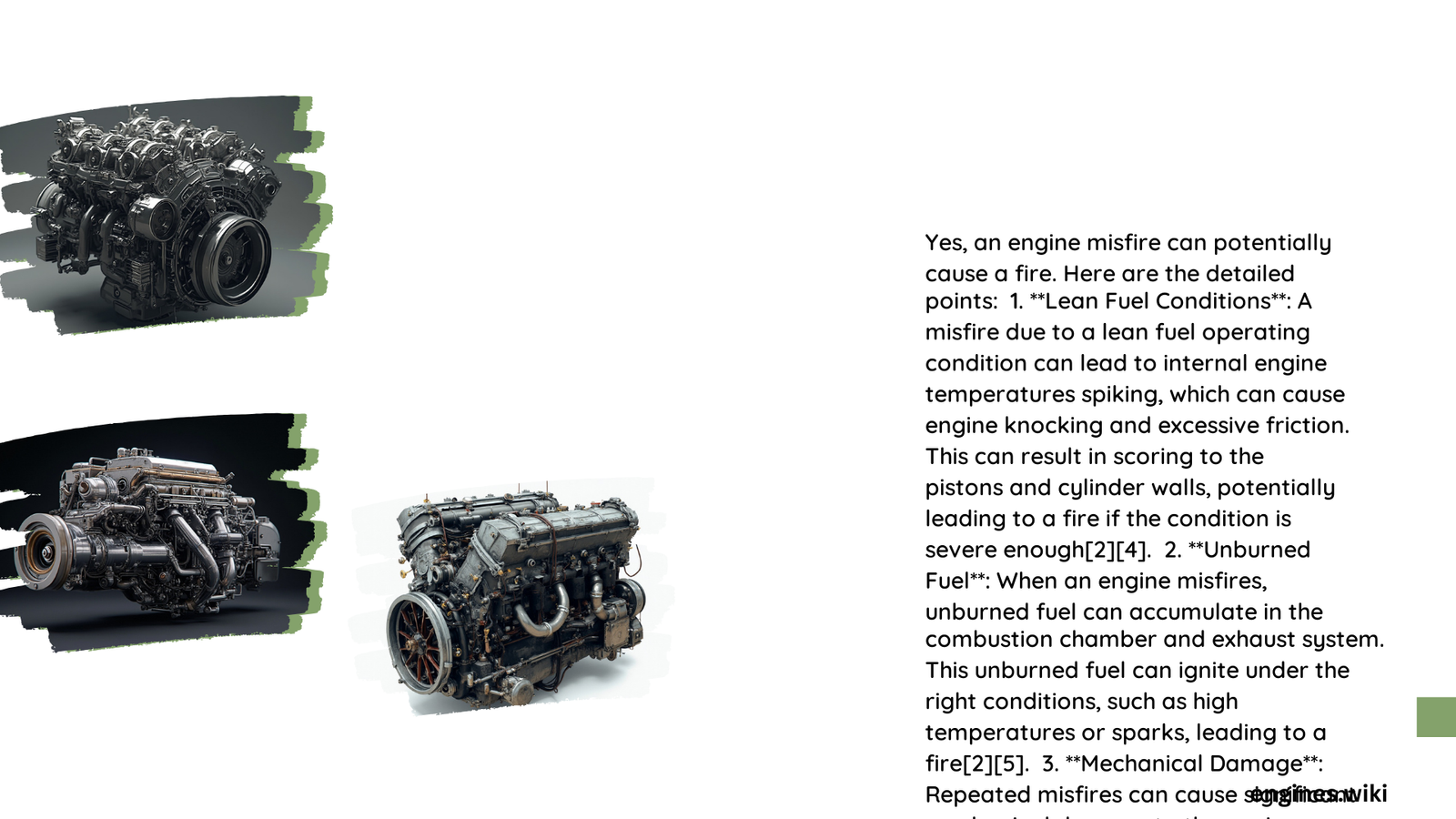An engine misfire can potentially lead to a fire under certain conditions. While not every misfire results in a fire, the risk increases with severe or prolonged misfires. Unburned fuel, overheating components, and electrical issues associated with misfires can create hazardous situations. Understanding the mechanisms, risks, and preventive measures is crucial for vehicle safety and maintenance.
What Are the Main Causes of Engine Misfires?
Engine misfires can occur due to various reasons:
- Faulty spark plugs
- Damaged fuel injectors
- Vacuum leaks
- Worn-out ignition coils
- Low compression in cylinders
- Clogged fuel filters
- Malfunctioning oxygen sensors
These issues can disrupt the delicate balance of fuel, air, and spark required for proper combustion, leading to misfires.
How Does an Engine Misfire Increase Fire Risk?

An engine misfire can increase the risk of fire through several mechanisms:
-
Unburned Fuel Accumulation: When a cylinder misfires, unburned fuel can enter the exhaust system. This fuel may ignite in the hot catalytic converter, potentially causing damage or even a fire.
-
Overheating Components: Misfires can cause certain engine components to overheat, particularly the catalytic converter. Temperatures in this component can exceed 1000°C (1832°F) during severe misfires, far beyond normal operating temperatures.
-
Increased Load on Functioning Cylinders: When one or more cylinders misfire, the remaining cylinders must work harder to compensate. This increased load can lead to overheating and accelerated wear.
-
Fuel Leaks: Severe misfires can sometimes cause fuel system components to fail, potentially leading to fuel leaks. If this leaked fuel comes into contact with hot engine parts, it could ignite.
What Are the Critical Temperature Thresholds for Fire Risk?
Understanding the temperature thresholds at which different components become fire risks is crucial:
| Component | Normal Operating Temperature | Critical Temperature |
|---|---|---|
| Engine Oil | 90°C – 104°C (194°F – 220°F) | >150°C (302°F) |
| Catalytic Converter | 300°C – 500°C (572°F – 932°F) | >1000°C (1832°F) |
| Exhaust Manifold | 400°C – 600°C (752°F – 1112°F) | >800°C (1472°F) |
| Cylinder Head | 100°C – 120°C (212°F – 248°F) | >150°C (302°F) |
When these components exceed their critical temperatures due to misfires, the risk of fire increases significantly.
Can Fuel Leakage from a Misfire Cause Ignition?
Yes, fuel leakage resulting from a misfire can potentially cause ignition under certain conditions:
-
Presence of an Ignition Source: Hot engine components, electrical sparks, or the catalytic converter can serve as ignition sources for leaked fuel.
-
Fuel Type: Gasoline is more volatile and easier to ignite than diesel fuel, but both can pose fire risks if they leak onto hot surfaces.
-
Leak Location: Fuel leaks near hot exhaust components or electrical systems are more likely to ignite.
-
Leak Rate: Even small leaks can be dangerous if the fuel contacts an ignition source. However, larger leaks pose a greater risk due to the increased volume of flammable material.
How Do Spark Plug Failures Contribute to Fire Risk?
Spark plug failures can significantly contribute to fire risk in several ways:
-
Incomplete Combustion: Failed spark plugs can lead to incomplete fuel combustion, allowing unburned fuel to enter the exhaust system and potentially ignite in the catalytic converter.
-
Increased Misfire Frequency: As spark plugs wear out or fail, the frequency of misfires increases, exacerbating all the associated risks.
-
Electrical Arcing: In some cases, severely damaged spark plugs can cause electrical arcing outside the combustion chamber, potentially igniting fuel vapors or other flammable materials.
-
Heat Build-up: Faulty spark plugs can cause individual cylinders to run hotter than normal, contributing to overall engine overheating.
What Are the Statistics on Engine Misfire-Related Fires?
While specific statistics on engine misfire-related fires are not readily available, we can consider some related data:
- According to the National Fire Protection Association (NFPA), mechanical or electrical failures cause approximately 19% of highway vehicle fires.
- The U.S. Fire Administration reports that vehicle fires account for about 15% of all fires reported to fire departments.
These statistics underscore the importance of proper vehicle maintenance in preventing fires, including addressing engine misfires promptly.
How Can You Prevent Misfire-Related Fire Risks?
To minimize the risk of fires caused by engine misfires, consider the following preventive measures:
-
Regular Maintenance: Follow your vehicle’s recommended maintenance schedule, including spark plug replacements and fuel system checks.
-
Prompt Repairs: Address any check engine lights or misfire symptoms immediately to prevent escalation of issues.
-
Quality Parts: Use high-quality replacement parts, especially for critical components like spark plugs and ignition coils.
-
Fuel System Care: Use fuel system cleaners periodically and ensure you’re using the correct fuel grade for your vehicle.
-
Professional Inspections: Have your vehicle inspected by a qualified mechanic regularly, especially if you notice any unusual engine behavior.
By following these preventive measures and staying vigilant about your vehicle’s performance, you can significantly reduce the risk of misfire-related fires and ensure safer operation of your vehicle.
Conclusion
While an engine misfire can potentially cause a fire, it’s important to note that not all misfires lead to fires. However, the risk is real and should be taken seriously. Understanding the mechanisms by which misfires can increase fire risk, recognizing the symptoms of misfires, and taking prompt action to address them are crucial steps in maintaining vehicle safety. Regular maintenance, quality repairs, and attentiveness to your vehicle’s performance can go a long way in preventing misfire-related fires and ensuring a safer driving experience.
References:
1. Autodoc – Car engine misfires: overheating and other dangerous symptoms
2. Cars.com – What Is an Engine Misfire and What Causes It?
3. ILOT.Lukasiewicz.gov.pl – OVERVIEW OF ENGINE MISFIRE DETECTION METHODS USED IN MODERN VEHICLES
4. National Fire Protection Association – Vehicle Fire Trends and Patterns
5. U.S. Fire Administration – Vehicle Fire Safety
